For several times I have tried to recount the stories of my first serious backpacking trip but failed: The memory just slipped away, as time flies by. But that only makes what's left all too precious to let go.
It was the summer of 2000. We had a rather ambitious plan for our limited travel experience: Dunhuang and Tibet, two relatively less traveled places in China. The following was my itinerary:
Beijing
|
Lanzhou
|
Liuyuan <--> Dunhuang
|
Jiayuguan
|
Xining <--> Qinghai Lake
|
Golmud
|
Lhasa <--> Xigazê
|
Chengdu
|
Mianyang
Our main means of transportation was the train. When the train was not available, we traveled by bus or by air. The hardest leg was a grueling 36-hour coach ride from Golmud to Lhasa; the easiest, a 2-hour flight from Lhasa to Chengdu.
Now I'll write down the pieces I remember about each places.
Lanzhou:
The first city we saw in the west changed our view. It reminded us that Beijing was not the real China, in the sense that New York City is not the real America. The city was dirty, so was the Yellow River. After all, it was not much of a tourist destination. The living cost was much lower than Beijing, as evident from the price of a decent meal. We had the famous Lanzhou Stretching Noodle (兰州拉面) and it was the best we ever had.
Liuyuan:
Liuyuan was the closest town to Dunhuang (敦煌) you could reach by train. We arrived late so we had to take a taxi. It was a 2-hour ride in the Gobi desert and our drive played a cassette of "Tibetan pop", i.e., modernized Tibetan folk songs. Some of them were really catchy and I later identified one hip-pop song I liked very much: 《岭格萨尔王》by 亚东。
Dunhuang:
We visited the Mogao Caves (莫高窟) and astounded by the frescos and sculptures. However, only a few caves were opened to the public for guided tours. We also visited the Singing Sands Mountain (鸣沙山), a sand dune that makes noise when heavy wind blows, and the Crescent Moon Lake (月牙泉), a crescent-shaped oasis. I was excited to see a desert for the first time. But you got bored (and dirty) after a while. We experienced the shortage of water in our hotel. Eventually the staff got us a basket of water, which we barely managed to clean ourselves.
Jiayuguan:
The last fortress was also the symbolic west end of the Great Wall. The west was an endless desert that inspired lots of poems, most of them sad.
Xining:
The capital of Qinghai was even poorer than Lanzhou. Shortage of water was more severe, too. We visited the Ta'er Monastery (a.k.a. Kumbum Monastery), a Tibetan Buddhism temple of high importance. It was the birth place of Tsongkhapa (宗喀巴), the founder of the dominant Gelug school ("Yellow Hats") of Tibetan Buddhism. The First Dalai Lama was one of his students. We hired a private guide and learned a lot about Tibetan Buddhism, which made our later trip more interesting. The Monastery was crowded by tourists and faithfuls alike.
The next day we took a bus to visit the Qinghai Lake. One of the places the bus took us to was called the Bird Island (鸟岛), where the birds inhabited on rocks in large quantities.
Golmud:
This was where the almighty Chinese railway system ended, until the railway to Lhasa was finished in 2006. Golmud (格尔木) had two major buildings: The train station and the bus station. We got off the train station and walked literally across the street to take the bus. It was the ride I would never take again.
We crossed the Tanggula Pass (唐古拉山口), the highest point (5072m) we would ever reach. Proudly I had my picture taken. We had some altitude sickness but mostly just headaches.
We met a young solider, about the same age as us, on the bus. He was very friendly and offered us help to get a room in a PLA-owned hotel (西藏军区第二招待所), which was decent and reasonably priced. We took the advice to have a good rest for the first day.
Lhasa:
The Potala Palace stood prominently at the center of the city. On a cloudy day, it looked just like a palace in heaven. We walked all the way up and saw where the Dalai Lama (达赖喇嘛) used to live and to rule. Needless to say, his apartment had the best view of Lhasa.
The next attraction was Jokhang Temple (大昭寺). We were luck to be there on a prayer day, when the admission was free. We followed the locals to spin the prayer wheels and to pray in front of statues of Buddha. The Golden Roof was surreal to look at on a sunny day.
The monks there were very friendly and we kept ourselves quiet inside the temple with respect. The most revered figure throughout Tibet was Tsongkhapa, as you could find his statue virtually everywhere. Maitreya (弥勒) and Manjusri (文殊) had their share of veneration as in other Buddhist countries.
Some local favorites were the Green Tara (绿度母) and the White Tara (白度母).
The street surrounded Jokhang was the Barkhor (八廓街), the biggest market place in Lhasa. There were so many souvenirs that we were overwhelmed pretty soon.
It was our goal to visit all three great monasteries of Lhasa: Sera (色拉), Drepung (哲蚌) and Ganden (甘丹). They were located in quiet suburbs and could be reached by bus. By now I had forgotten their stories and uniqueness. The only thing I could remember was that it wasn't easy to visit all three in one trip but somehow we made it. Amituofo! (In Chinese, “阿弥陀佛!”, analogous to "God Bless!")
Xigazê:
We then took a day trip to Xigazê/Shigatse (日喀则), the second largest city in Tibet. The main attraction was Tashilhunpo Monastery (扎什伦布寺), where Panchen Lama (班禅喇嘛), the second highest ranking after Dalai Lama, resided. Unfortunately we arrived on Sunday and the Monastery was closed for public visit. I was ready to accept the fate but my friend, Xuezheng, couldn't give it up. So we wandered around the gate for a while until a monk kindly asked us to come in. He told us that he could only let us see the famous statue of a 86-foot-high Maitreya (Jambu) Buddha and several other main halls. We were more than grateful and followed him. After the visit, he invited us to his apartment and we had a nice talk. He said he was honored to be a staff member of the Panchen Lama, who was studying in Beijing right now. We told him that we came from Beijing and we complained about how hot it was in Beijing during the summer.
"That's why I take a vacation back here." He laughed. Indeed, their apartments were built in a good way so they were cool even without air conditioning.
He gave each of us a red rope (红绳) as a departing gift; we took turns to have a picture with him. Now I couldn't find either.
Had we had more time, we would have visited Norbulingka (罗布林卡), the summer palace and Nam Co/Namtso (纳木错), the Holy Lake.
Chengdu:
Leaving Lhasa, one of my friend, Zaifang, took a flight back to his home in Xining. Xuezheng and I took a flight to Chengdu. By the way, the Lhasa Gonggar Airport was two hours' bus ride away from the city because it was hard to find a place to build an airport in the mountainous Tibetan Plateau.
I took a train directly back to my home in Mianyang while Xuezheng continued his grand tour all the way to Chongqing, Wuhan, then back to Beijing.
For years I have bragged about my trip to Dunhuang and Tibet. It was unforgettable.
It was the summer of 2000. We had a rather ambitious plan for our limited travel experience: Dunhuang and Tibet, two relatively less traveled places in China. The following was my itinerary:
Beijing
|
Lanzhou
|
Liuyuan <--> Dunhuang
|
Jiayuguan
|
Xining <--> Qinghai Lake
|
Golmud
|
Lhasa <--> Xigazê
|
Chengdu
|
Mianyang
Our main means of transportation was the train. When the train was not available, we traveled by bus or by air. The hardest leg was a grueling 36-hour coach ride from Golmud to Lhasa; the easiest, a 2-hour flight from Lhasa to Chengdu.
Now I'll write down the pieces I remember about each places.
Lanzhou:
The first city we saw in the west changed our view. It reminded us that Beijing was not the real China, in the sense that New York City is not the real America. The city was dirty, so was the Yellow River. After all, it was not much of a tourist destination. The living cost was much lower than Beijing, as evident from the price of a decent meal. We had the famous Lanzhou Stretching Noodle (兰州拉面) and it was the best we ever had.
Liuyuan:
Liuyuan was the closest town to Dunhuang (敦煌) you could reach by train. We arrived late so we had to take a taxi. It was a 2-hour ride in the Gobi desert and our drive played a cassette of "Tibetan pop", i.e., modernized Tibetan folk songs. Some of them were really catchy and I later identified one hip-pop song I liked very much: 《岭格萨尔王》by 亚东。
Dunhuang:
We visited the Mogao Caves (莫高窟) and astounded by the frescos and sculptures. However, only a few caves were opened to the public for guided tours. We also visited the Singing Sands Mountain (鸣沙山), a sand dune that makes noise when heavy wind blows, and the Crescent Moon Lake (月牙泉), a crescent-shaped oasis. I was excited to see a desert for the first time. But you got bored (and dirty) after a while. We experienced the shortage of water in our hotel. Eventually the staff got us a basket of water, which we barely managed to clean ourselves.
Jiayuguan:
The last fortress was also the symbolic west end of the Great Wall. The west was an endless desert that inspired lots of poems, most of them sad.
Xining:
The capital of Qinghai was even poorer than Lanzhou. Shortage of water was more severe, too. We visited the Ta'er Monastery (a.k.a. Kumbum Monastery), a Tibetan Buddhism temple of high importance. It was the birth place of Tsongkhapa (宗喀巴), the founder of the dominant Gelug school ("Yellow Hats") of Tibetan Buddhism. The First Dalai Lama was one of his students. We hired a private guide and learned a lot about Tibetan Buddhism, which made our later trip more interesting. The Monastery was crowded by tourists and faithfuls alike.
The next day we took a bus to visit the Qinghai Lake. One of the places the bus took us to was called the Bird Island (鸟岛), where the birds inhabited on rocks in large quantities.
Golmud:
This was where the almighty Chinese railway system ended, until the railway to Lhasa was finished in 2006. Golmud (格尔木) had two major buildings: The train station and the bus station. We got off the train station and walked literally across the street to take the bus. It was the ride I would never take again.
We crossed the Tanggula Pass (唐古拉山口), the highest point (5072m) we would ever reach. Proudly I had my picture taken. We had some altitude sickness but mostly just headaches.
We met a young solider, about the same age as us, on the bus. He was very friendly and offered us help to get a room in a PLA-owned hotel (西藏军区第二招待所), which was decent and reasonably priced. We took the advice to have a good rest for the first day.
Lhasa:
The Potala Palace stood prominently at the center of the city. On a cloudy day, it looked just like a palace in heaven. We walked all the way up and saw where the Dalai Lama (达赖喇嘛) used to live and to rule. Needless to say, his apartment had the best view of Lhasa.
The next attraction was Jokhang Temple (大昭寺). We were luck to be there on a prayer day, when the admission was free. We followed the locals to spin the prayer wheels and to pray in front of statues of Buddha. The Golden Roof was surreal to look at on a sunny day.
The monks there were very friendly and we kept ourselves quiet inside the temple with respect. The most revered figure throughout Tibet was Tsongkhapa, as you could find his statue virtually everywhere. Maitreya (弥勒) and Manjusri (文殊) had their share of veneration as in other Buddhist countries.
Some local favorites were the Green Tara (绿度母) and the White Tara (白度母).
The street surrounded Jokhang was the Barkhor (八廓街), the biggest market place in Lhasa. There were so many souvenirs that we were overwhelmed pretty soon.
It was our goal to visit all three great monasteries of Lhasa: Sera (色拉), Drepung (哲蚌) and Ganden (甘丹). They were located in quiet suburbs and could be reached by bus. By now I had forgotten their stories and uniqueness. The only thing I could remember was that it wasn't easy to visit all three in one trip but somehow we made it. Amituofo! (In Chinese, “阿弥陀佛!”, analogous to "God Bless!")
Xigazê:
We then took a day trip to Xigazê/Shigatse (日喀则), the second largest city in Tibet. The main attraction was Tashilhunpo Monastery (扎什伦布寺), where Panchen Lama (班禅喇嘛), the second highest ranking after Dalai Lama, resided. Unfortunately we arrived on Sunday and the Monastery was closed for public visit. I was ready to accept the fate but my friend, Xuezheng, couldn't give it up. So we wandered around the gate for a while until a monk kindly asked us to come in. He told us that he could only let us see the famous statue of a 86-foot-high Maitreya (Jambu) Buddha and several other main halls. We were more than grateful and followed him. After the visit, he invited us to his apartment and we had a nice talk. He said he was honored to be a staff member of the Panchen Lama, who was studying in Beijing right now. We told him that we came from Beijing and we complained about how hot it was in Beijing during the summer.
"That's why I take a vacation back here." He laughed. Indeed, their apartments were built in a good way so they were cool even without air conditioning.
He gave each of us a red rope (红绳) as a departing gift; we took turns to have a picture with him. Now I couldn't find either.
Had we had more time, we would have visited Norbulingka (罗布林卡), the summer palace and Nam Co/Namtso (纳木错), the Holy Lake.
Chengdu:
Leaving Lhasa, one of my friend, Zaifang, took a flight back to his home in Xining. Xuezheng and I took a flight to Chengdu. By the way, the Lhasa Gonggar Airport was two hours' bus ride away from the city because it was hard to find a place to build an airport in the mountainous Tibetan Plateau.
I took a train directly back to my home in Mianyang while Xuezheng continued his grand tour all the way to Chongqing, Wuhan, then back to Beijing.
For years I have bragged about my trip to Dunhuang and Tibet. It was unforgettable.

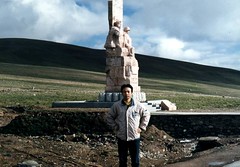
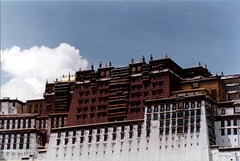
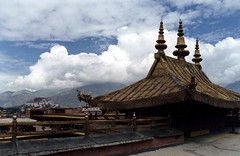
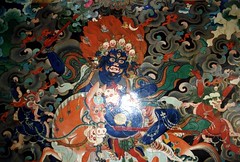
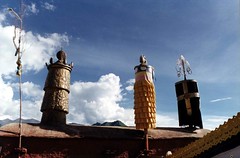
Comments
英文水平有限,好看,但头疼啊~~~~